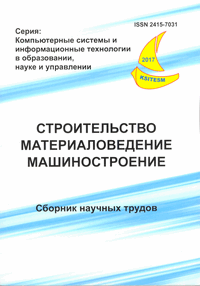Modelling of hydraulic shears operation with an eccentric intensifier in order to increase efficiency and decrease energy costs
Keywords:
demolition of buildings and structures, intensification, eccentric mechanism, destruction of concrete, reconstruction, increasing safetyAbstract
Purpose. There are a number of different equipment for the destruction of the concrete during the renovation or demolition. A common drawback of most of this equipment is that they perform only the process of destruction by the forces of compression. As is known, concrete works well on contraction and therefore for its destruction requires a large effort. It is necessary to create a new or improvement of known equipment for the destruction of the concrete during the demolition of buildings and structures to improve the efficiency of the process, taking into account the demolition of reference works security. Methodology. A study of the equipment was carried out by a physical simulation of concrete failure process. Findings. According to the study of concrete failure process established rational parameters of hydraulic shears with intensifier. Improvement of equipment for demolition will allow to destroy the concrete with greater productivity and efficiency, while providing a high level of security. Originality. Known equipment for concrete deterioration is a common drawback - they only work in compression. There is a need to improve the well-known and the creation of new equipment for the destruction of the concrete during the demolition of buildings and structures. The proposed equipment will improve the performance of practical significance. Practical value. Using the equipment for the destroying of concrete with the intensification can improve the efficiency of the process of concrete destruction demolition of buildings and structures, at the same time reduce energy consumption and extend the life of hydraulic equipment.References
Belikov A.S., Melashich V.V. and Sichko I.N. Issledovaniye parametrov raboty gidronozhnits s ekstsentrikovym intensifikatorom s tseliu povysheniia effektivnosti i ponizheniia energozatrat [Researching of parameters of hydraulic shears with an eccentric intensifier in order to increase efficiency and decrease energy costs]. Stroitelstvo, materialovedeniye, mashinostroeniye [Ceronstruction, material science, mechanical engineering]. 2016, no. 3, pp. 281-285. (in Russian).
Volkova N. V., Efimova E. I. Problemy obespecheniya okhrany truda v stroitelnoy otrasli [Problems of labor protection in the construction industry]. Internet-zhurnal «Naukovedeniye» [Internet magazine Naukovedenie.] Vyipusk no. 1 (14). 2013. (in Russian).
Volfson V.L., Iliashenko V.A. and Komisarchik R.G. Rekonstruktsiia i kapitalnyy remont zhilykh i obschestvennykh zdaniy [Reconstruction and repair of residential and public buildings].– 2-e izd. Reprint. – Moscow: Stroyizdat Publ., 2004, 252 p. (in Russian).
Deviataeva G. V. Tekhnologiya rekonstruktsii i modernizatsii zdaniy [Technology renovation and modernization of buildings ]. [Teaching. Collec.]. Moscow: INFA, 2006, 250 p. (in Russian).
Melashich V.V.and Krasnoperov M.S. Povyshenie bezopasnosti vedeniia rabot pri rekonstruktsii zdaniy i sooruzheniy [Improving safety of work in the reconstruction of buildings and structures]. Naukovo-tekhn. zbirnyk [Naukovo-technologichnyi zbіrnik], 2011, pp. 44-45. (in Russian).
Belikov A.S., Kozhushko A.P. and Safonov V.V. Okhrana truda na predpriiatiiakh stroitelnoy industrii [labor protection in enterprises of the construction industry]. Dnepropetrovsk: Fedorchenko A. A. Publ., 2010, 528 p. (in Russian).
Spetsialne roboche obladnannia ekskavatora [Specially not only the owner of the excavator]. Patent 61687., Ukraine), МПК Е02F 3/ 28 (2006.01). / Melashich V.V. and Sichko I.M. zaiavnyk i vlasnyk patentu DVNZ «PDABA». – № u201100177; zayavl. 04.01.11; opubl. 25.07.11. Bul № 14. (in Ukrainian).
Code of practice for demolition of buildings, 2004. Available at: http://www.bd.gov.hk/english/documents/code/Demolition_e2004.pdf
Demolition Planning / Richard Diven and Michael R. Taylor, CAE. The Architect’s Handbook of Professional Practice, 2006. Available at: http://www.aia.org/aiaucmp/groups/aia/documents/pdf/aiab089227.pdf
Green Demolition and Sustainable Deconstruction / Lawrence L. Fieber, Burns & McDonnell Engineering, 2009. Available at: http://www.burnsmcd.com/Resource_/PressRelease/1452/FileUpload/GreenDemolition-Fieber.pdf
Downloads
Published
Issue
Section
License
Редакція Видання категорично засуджує прояви плагіату в статтях та вживає всіх можливих заходів для його недопущення. Плагіат розглядається як форма порушення авторських прав і наукової етики.
При виявлені у статті більш ніж 25% запозиченого тексту без відповідних посилань та використання лапок, стаття кваліфікується як така, що містить плагіат. У цьому випадку стаття більше не розглядається редакцією, а автор отримує перше попередження.
Автори, в статтях яких повторно виявлено плагіат, не зможуть публікуватися в усіх журналах Видавництва ДВНЗ «Придніпровська державна академія будівництва та архітектури».
Автори, які публікуються у цьому журналі, погоджуються з наступними умовами:
- Автори залишають за собою право на авторство своєї роботи та передають журналу право першої публікації цієї роботи на умовах ліцензії Creative Commons Attribution License, котра дозволяє іншим особам вільно розповсюджувати опубліковану роботу з обов'язковим посиланням на авторів оригінальної роботи та першу публікацію роботи у цьому журналі.
- Автори мають право укладати самостійні додаткові угоди щодо неексклюзивного розповсюдження роботи у тому вигляді, в якому вона була опублікована цим журналом (наприклад, розміщувати роботу в електронному сховищі установи або публікувати у складі монографії), за умови збереження посилання на першу публікацію роботи у цьому журналі.
- Політика журналу дозволяє і заохочує розміщення авторами в мережі Інтернет (наприклад, у сховищах установ або на особистих веб-сайтах) рукопису роботи, як до подання цього рукопису до редакції, так і під час його редакційного опрацювання, оскільки це сприяє виникненню продуктивної наукової дискусії та позитивно позначається на оперативності та динаміці цитування опублікованої роботи (див. The Effect of Open Access).

